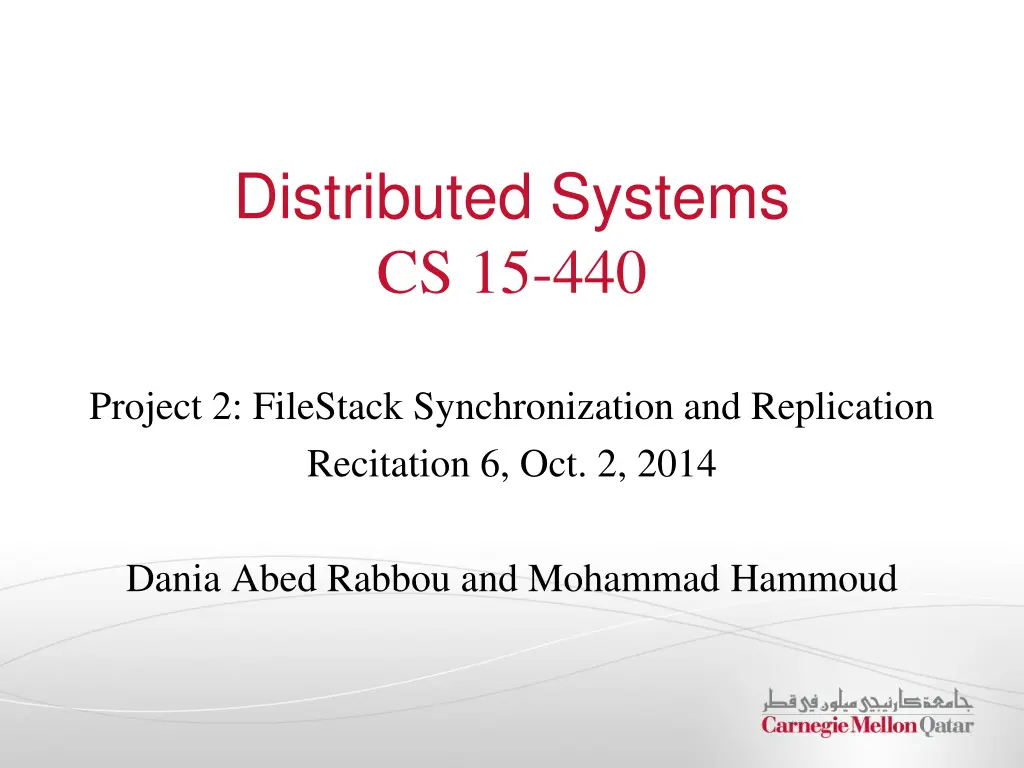
Efficient File Synchronization and Replication Strategies
Enhance your understanding of file synchronization, replication, and storage server architecture in distributed systems. Explore communication paradigms between entities and ensure file correctness and consistency. Dive deep into synchronization algorithms and replication techniques for achieving fairness, load balancing, and consistency in shared and replicated files.
Download Presentation

Please find below an Image/Link to download the presentation.
The content on the website is provided AS IS for your information and personal use only. It may not be sold, licensed, or shared on other websites without obtaining consent from the author. If you encounter any issues during the download, it is possible that the publisher has removed the file from their server.
You are allowed to download the files provided on this website for personal or commercial use, subject to the condition that they are used lawfully. All files are the property of their respective owners.
The content on the website is provided AS IS for your information and personal use only. It may not be sold, licensed, or shared on other websites without obtaining consent from the author.
E N D
Presentation Transcript
Distributed Systems CS 15-440 Project 2: FileStack Synchronization and Replication Recitation 6, Oct. 2, 2014 Dania Abed Rabbou and Mohammad Hammoud
Logistics P2_StarterCode: Copy files into your project1 folder Project Due Date: Oct. 22, 2014 Q&A: Piazza, Office Hours, & Appointments
P1: FileStack Applied communication and Remote Method Invocation (RMI) to build a Distributed File System denoted as FileStack the knowledge of client-server Employed communication, thereby transparently locating and manipulating files stored remotely at a cluster of machines stubs and skeletons to mask
Entities & Architecture Storage Servers (SSs) Each SS stores physically files to share in a directory (denoted as temporary directory) in its local file system Naming Server (NS) Stores metadata about all shared files in the form of a mapping from filenames to storage servers (like DNS) Clients Perform operations on files (e.g., write, read etc.) Architecture Based on client-server architecture
Communication between Entities (3) CreateFile, CreateDirectory, IsDirectory, Delete, List, GetStorage (1) Registration (4) Results, Storage Server (2) Duplicate Files, Create, Delete (5) Read, Write, Size (6) Results Request-Reply Communication Paradigm
File Correctness & Consistency Did we allow multiple clients to write on a file? YES! Did we allow a client to read a file under modification? YES!! Client C P3 Storage Server Shared File abc.txt Client B P2 Read from file abc.txt Write to file abc.txt Client A P1 Write to file abc.txt
Project 2 Objectives 1. Devise and apply a synchronization algorithm that: achieves correctness while sharing files and ensures fairness to clients. 2. Devise and apply a replication algorithm that: achieves load-balancing among storage servers and ensures consistency of replicated files.
Logical Synchronization of Readers and Writers
Mutual Exclusion Readers: Reader is a Client who wishes to read a file at a SS Reader first requests a read/non-exclusive/shared lock Writer: Writer is a Client who wishes to write to a file at a SS Writer first requests a write/exclusive lock Order: Readers and writers are queued and served in the FIFO order
Read Locks Readers do not modify contents of a file/directory Readers request the NS for read locks before reading files Readers unlock files once done Multiple readers can acquire a read lock simultaneously
Write Locks Writers can modify contents of files/directories Writers request the NS for write locks before reading/writing to files Writers unlock files once done Only one writer can acquire a write lock at a time
Write Locks (Contd) NS grants a write lock on a file if: No reader is currently reading the file No writer is currently writing to the file NS uses read locks on all the directories in the parent path to prevent modifications Assume a writer requests a write lock for project2.txt /FileStack/users/student1/work/project2.txt NS first applies read locks to all directories in the path NS then grants a write lock to the requestor of project2.txt
Service Interface Two new operations available to Clients LOCK(path, read/write) UNLOCK(path, read/write)
Dynamic Replication of Files
Number of Replicas Num_requests: number of read requests to a file Num_requests_coarse: num_requests rounded to the nearest multiple of 20 Num_replicas = min ( * num_requests_coarse, UPPER_BOUND) where & UPPER_BOUND are constants
When to Replicate? NS stores num_requests as file metadata However, we know that Clients invoke read operations on storage servers So, how can the NS learn about read operations & hence update num_requests?
When to Replicate? (Contd) NS deems a Client s request for a read lock on a file as a read operation Hence, NS increments num_requests associated with the file and re-evaluates num_replicas
How to Replicate? NS first elects SSs to store the replicas NS commands each SS to copy the file from the original SS Hence, the metadata of a file now contains a set of SSs
How to Update Replicas? When a Client requests a write lock on a file, it causes the NS to invalidate all the replicas except the locked one Invalidation is achieved by commanding those SSs hosting replicas to delete the file When the Client unlocks the file, the NS commands SSs to copy the modified file
Command Interface The new operation available to the NS: Copy(path, StorageStub)






















